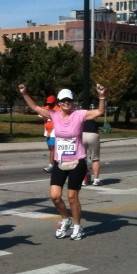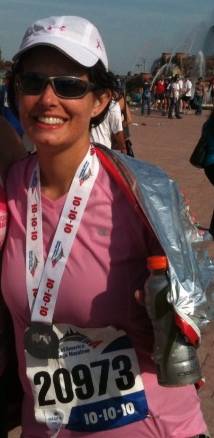I have been, my dear readers, at a loss for words these past weeks following the Bank of America Chicago Marathon on 10/10/10 and with it, Sally’s attempt at joining the likes of Deena Kastor, Kara Goucher, and the queen of American marathon running, Joan Benoit Samuelson. Who among us could ever forget the moment Joanie entered the Coliseum during the 1984 Olympic Games in Los Angeles to win the first women’s Olympic marathon event? Yes, I was nine at the time, and I do remember it.
It was with that spirit that I watched (remotely) our newb take to the streets of Chicago. You may remember Harry and Sally as our running newbs, starting the year as couch potatoes and moving into the running world with cautious egos and outlandish goals. Harry fell by the wayside quickly, moving out to pasture, so to speak, hitting the golf course harder than the pavement. Sally, our heroine, strode forth with unbending knee until hers gave out, putting marathon victory at risk and becoming just another one of those “I told you so” runners. Well, my friends, do I have a story for you.
 The day was warm, uncomfortably so for marathon running. Some of you may remember in 2007 when the Chicago Marathon was stopped and runners were asked to step off the course because temperatures reached 88 degrees. One runner died (although it was later attributed to an existing heart condition). Although temperatures this year weren’t as bad as that year, Sally was dreading the worst.
The day was warm, uncomfortably so for marathon running. Some of you may remember in 2007 when the Chicago Marathon was stopped and runners were asked to step off the course because temperatures reached 88 degrees. One runner died (although it was later attributed to an existing heart condition). Although temperatures this year weren’t as bad as that year, Sally was dreading the worst.
“I was a nervous wreck,” Sally said. “The 10 day forecast said 70 degrees and sunny for October 10th — perfect! As the date got closer, the forecasted high went up and up, and on Saturday the forecast was for sunny and upper 80s.”
For those uninitiated in perfect marathon weather conditions, the ideal would be temperatures in the upper 40s or lower 50s, overcast or partly cloudy, low humidity, and, of course, a gentle wind at your back (the entire run). This year’s weather was shaping up to be a disaster.
Sally was worried, and with good reason. “So, here I was, already unprepared because my leg issues kept me from key training runs, incredibly slow on a good day, and now having to deal with hot temperatures that would impact even the best of runners…I was in a near panic!”
The weather played a factor in what Sally brought to the race as well. Sometimes we don’t think enough about what to wear come race day. We’re so worried about the training and eating that clothes come as an afterthought.
“I had come prepared with a bunch of warm clothing that I would leave on the route, but when I walked out of the hotel on Sunday morning it was already pretty warm and I didn’t need it,” Sally said.
Sally was experiencing butterflies, as most runners do at the start of a big race. “I walked to the start with one of my friends who was a wonderful calming influence.” It took Sally about 30 minutes from when the gun went off until she crossed the start line. With so many people, 45,000 or so runners, it’s no wonder. “It was unbearable. I just wanted to get it over with!” she said. Yet, even with the delay, Sally was impressed by the crowd’s enthusiasm. “I was stunned by the energy of the crowds. It really was distracting and made things a lot better.”
Sally ran faster in the first few miles than she had intended; the excitement and euphoria of the moment overtaking her. This is a common effect come race day. Runners plan on running one pace, but in the moment, adrenaline kicks in and you go out too fast.
“I walked through water stops and when I would eat my sports beans, but I felt like I wanted to keep running. I was running faster than normal, but I had to be careful not to get too swept up in the energy and run too fast.”
Mile eight came quickly, and that’s when things got difficult. “I was pretty good about this until I reached Boystown (around mile eight), where I completely lost focus. There was just so much going on and so much energy that I think I ran my fastest pace ever. It was a great mental boost, but I paid the price.”
By mile 11, Sally hit a wall. “I was starting to drag, but luckily Harry surprised me and walked with me for a few blocks.” Support along the race route is a major boost to a marathoner’s mental state. That’s why it’s important that at the later stages of a marathon that the crowds are out in force.
“I focused on getting to the halfway mark because once I reached that point I knew that I would have to run less than I had just run. This was a mental game I played with myself during training and always made me feel better.”
Sally had Harry at mile 11, 17, 23 and at the finish line giving her encouragement. After mile 13, she had a friend run with her acting as cheerleader. “She not only offered continuous encouragement, but also made sure I was drinking enough.” Her friend ran miles 13–17 and 23–26 with her.
“At mile 17, I was tired, hurting, and feeling nauseous. I was seeing aid stations full of runners, runners crying on the curbs along the route, and even one person in an ambulance. At this point, I decided that my goal was just to finish and not worry about the medal. It wasn’t worth hurting myself or worse, so I began walking more than running.”
Yet it was touch and go. It was a mental battle with the police announcing behind her that street cleaners were coming even though there were none in sight. Despite that, though, Sally pushed through. And she got what she really wanted: her medal.
“I crossed the finish line with four minutes to spare, but wasn’t completely relieved until I had that medal around my neck! While a time of 6:26 is a little embarrassing, it’s not too bad for couch to a marathon in six months!”
Harry wasn’t so sure she was going to make it. He relayed his concerns one day over brunch. “I was looking at the clock and saw her pace group go by, and I started to worry,” he said.
So, how does Sally feel about being a marathoner?
“Overall, it was very challenging with many highs and lows. I am so thankful that most of my concerns were not realized. By mile 20 everything hurt, but my IT band never flared up, I didn’t have any chafing, and my toenails are still intact. Since my body cooperated, it was more of a mental challenge.”
Sally has mostly recovered from the whole experience, and she credits Facebook status updates and her fundraising for cancer research as reasons she stuck to it. “I just kept focusing on writing a Facebook status about finishing! I never would have been able to do it if I hadn’t been fundraising for a cause so close to my heart.”
You see, reader, this story is so much more powerful than one woman moving from couch to marathon in six months, or getting a stupid medal at the end of a run.
Last December, Sally had a double preventative mastectomy. She’d always known that cancer was a risk in her family. Her mother and three aunts all died of ovarian cancer. Sally’s mother went through genetic testing when she was diagnosed. She learned she had the BRCA 1 gene mutation, which drastically increased the chance of breast or ovarian cancer. In May of 2009, Sally tested for the gene mutation and learned she had it too. In June, Sally found out that one of her cousins her age was diagnosed with breast cancer. Sally decided she needed to be aggressive. Thus, she had the surgery, which reduces the risk of breast cancer by 90–95%.
“Going through this process, I met a number of women who were going through the same thing. The strength of these women in addition to the strength of my mom, aunts, and second cousin inspired me to attempt the marathon. I felt like I was so lucky to have the information to enable me to have preventative surgery, and that I was lucky just to be able to run. I used my story to raise money for the American Cancer Society and ended up raising more than $2,300 from 50+ people. I was amazed by the response to my fundraising, and it was the only thing that got me through marathon training. I never would have been able to run it just to run it, I needed a greater goal.”
Sally has been an inspiration to those who know her. It takes a lot of courage to make that decision. She did, and then she set her sights on a marathon. The marathon, in a very real way, was a cakewalk.
Nevertheless, we can now include Sally’s name, her real name, with the likes of Kastor, Goucher, and the grandmother of them all…Benoit Samuelson. Stacy Bennett is a marathoner.









